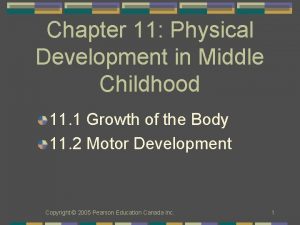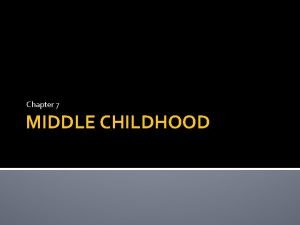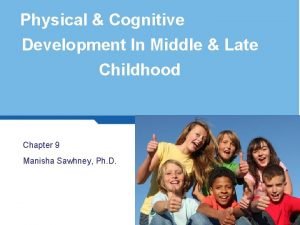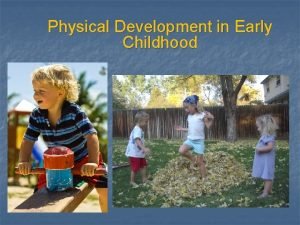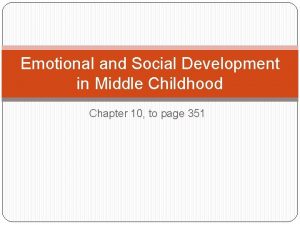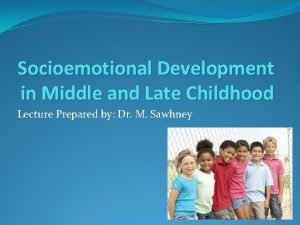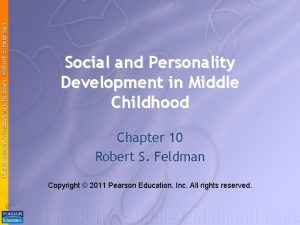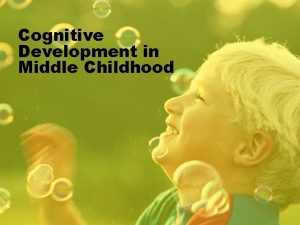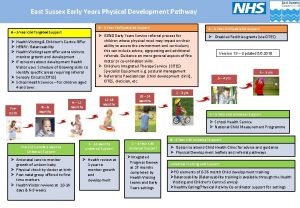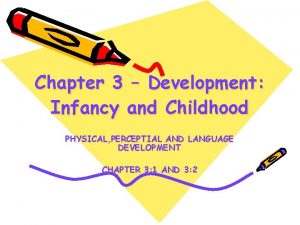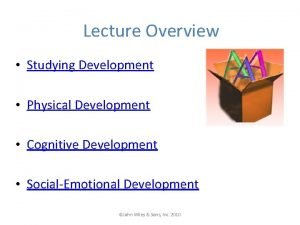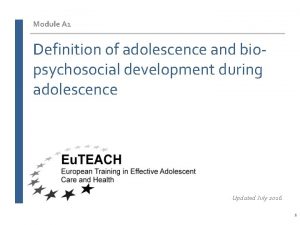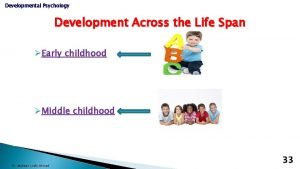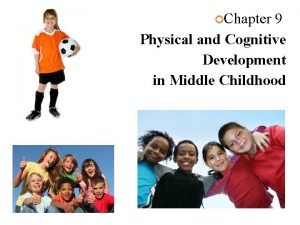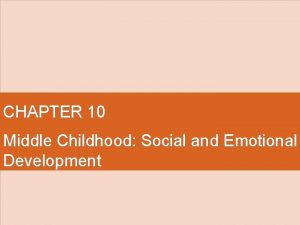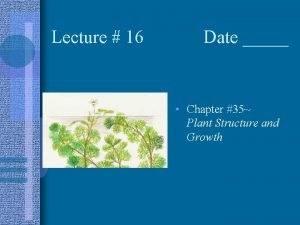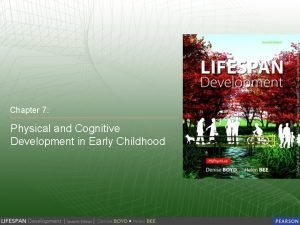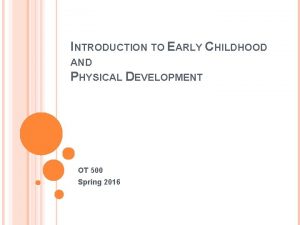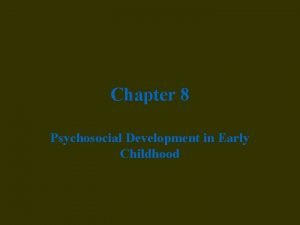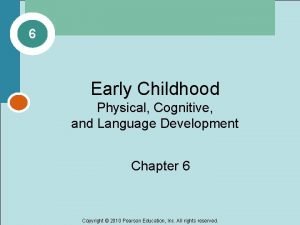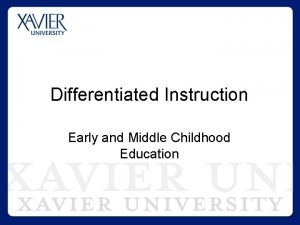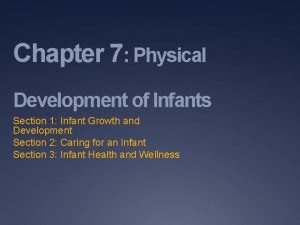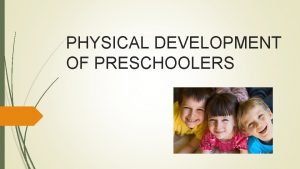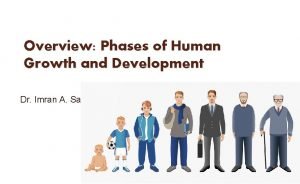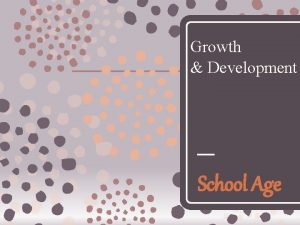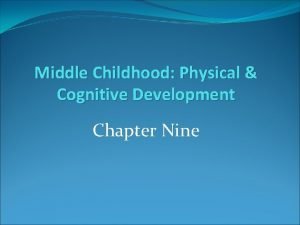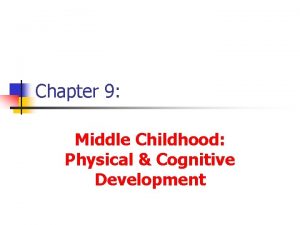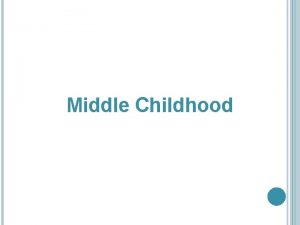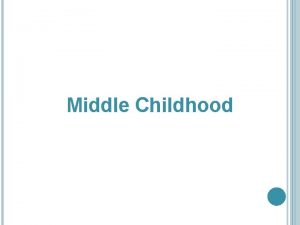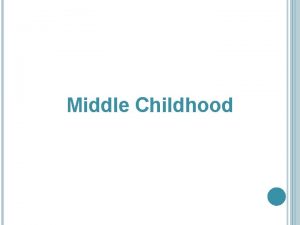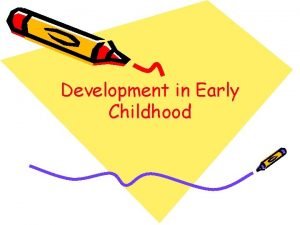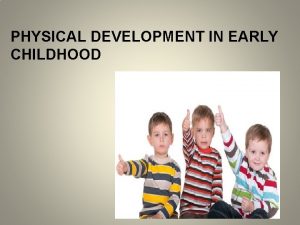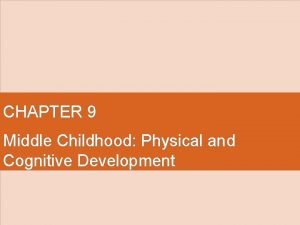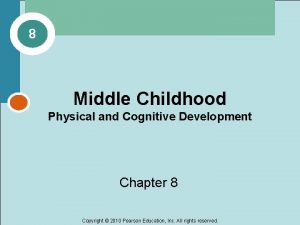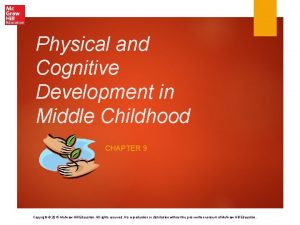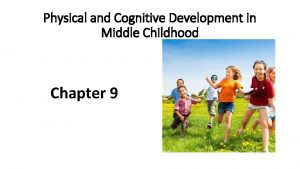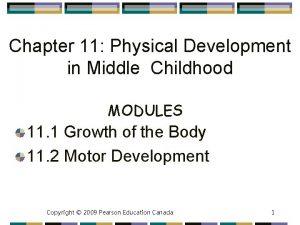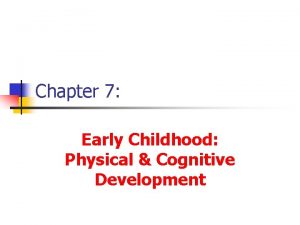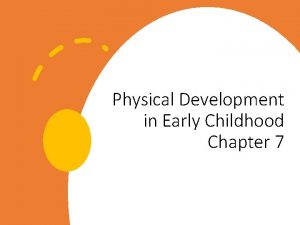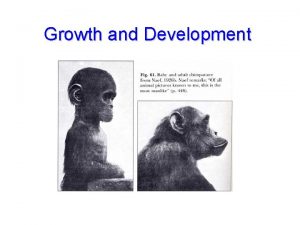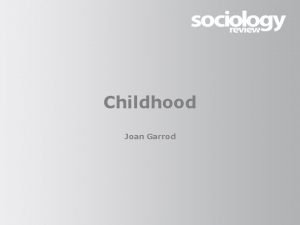Chapter 7 MIDDLE CHILDHOOD Physical Development Growth in



















































- Slides: 51

Chapter 7 MIDDLE CHILDHOOD

Physical Development

Growth in Middle Childhood Physical Growth and Sensory Development �Growth slow and steady �Boys slightly taller and more muscular �Lowest body mass index during this time �Nearsightedness (myopia) rises during middle childhood

Nutrition and Malnutrition �Malnutrition a problem even for resilient children �Guatemalan study found early differences nutrition affected longterm cognitive and social development

�Developed countries tend to have other nutrition problems. Overweight—BMI (body mass index) over 18 Obesity—BMI over 21 �In U. S. , overweight/obesity highest in least affluent ethnic minority groups �Increase in obesity due to changes in diet, television viewing

�Obesity can lead to social and physical consequences for children �Socially can lead to exclusion and ridicule �Can lead to later emotional and behavioral problems

�Can result in diabetes �At risk of becoming obese adults with more complications �First step of prevention: recognizing the problem. Research has shown that fewer than half of parents of obese children view their children as overweight.

Illness and Injuries �Death rates are lower than any other time period �Developed countries have seen decreases in illness �Asthma tends to have higher rates in middle childhood with boys at higher risk than girls

�Possible causes for the increase in asthma: the hygiene hypothesis and increased pollution �Most common cause of injury are automobile accidents and bicycle accidents

Motor Development Gross Motor Development �Advancement occurs in balance, strength, coordination, agility and reaction time �Involvement in organized sports increases �Boys more likely than girls to participate in sports but there are increases occurring worldwide �Screen time is displacing play time �It is recommended children get 60 minutes a day of physical activity

Fine Motor Development �Increased ability in fine motor skills �Writing improves and becomes smaller and neater �Fine motor skills will reach adult maturity by end of middle childhood �Gross motor skills continue to develop

Figure 7. 2 Change in Drawing Abilities from Early to Middle Childhood Drawings become more realistic as fine motor development advances during middle childhood. Here are drawings from a child at ages 3 (top left), 5 (left), and 7 (top right).

�http: //media. pearsoncmg. com/ph/hss_ar nett_humandevelopment_1/QRvideo/physica lfitness. m 4 v

Cognitive Development

Theories of Cognitive Development Piaget’s Concrete Operational Stage �Child is able to use mental operations to organize and manipulate information mentally �New abilities in conservation, classification and seriation

Information Processing/ADHD �Children exhibit selective attention during middle childhood �ADHD includes problems of inattention, hyperactivity, and impulsiveness �For most, it persists into adolescence and adulthood �Possible causes: genes, prenatal environment, and brain differences

�ADHD treatments include Medication, which can lead to some side effects Behavioral therapy including parenting training �Most both effective treatments include

Information Processing/Memory �Increased as: use of mnemonics such Rehearsal Organization Elaboration �Increased understanding of how memory works (metamemory) ones own memory.

Intelligence Testing �Intelligence testing examines individual differences in cognitive development �Most widely used test is the Wechsler Intelligence Test for Children and Wechsler Adult Intelligence Scale

�Intelligence is impacted by a combination of genes and environment �Research indicates each child has a reaction range for intelligence

�Environmental influences stronger for poor children than rich �Environmental improvements include better prenatal care, smaller families, television, and decline of infectious diseases

Alternate Theories of Intelligence �Gardner’s theory of multiple intelligences Linguistic Intelligence Logical-mathematical Intelligence Spatial Musical Bodily-kinesthetic Interpersonal Intrapersonal

�Sternberg’s theory focused on three distinct but related forms of intelligence �(CAP) Creative Intelligence—combine information in new ways Analytical Intelligence—what most IQ tests measure Practical Intelligence—apply information to everyday problems

Cognitive Skills of School: Math Skills �Math skills develop comparably to language skills Numeracy—understanding of numbers develops in first couple of weeks Counting begins by age two Simple addition and subtraction by five �Cultures vary in timing and approach to teaching math skills

Language Development Vocabulary, Grammar, and Pragmatics �Language development in middle childhood involves : Vocabulary—after formal schooling vocabulary expands greatly Grammar—becomes more complex and can be seen with use of conditional sentences Pragmatics—improves to a degree and can be seen in the understanding of humor

Language Development: Bilingualism �Learning a second language does not interfere with mastering the primary language �It is easier to learn language in early childhood than later in life �Benefits of being bilingual Better meta-linguistic skills—awareness of underlying structure of language Higher scores on general cognitive abilities

The Social and Cultural Contexts of Middle Childhood: School Experiences �School enrollment higher in developed countries �Expectations vary: Asian countries—high standards and hard work ▪ Emphasize obedience and cooperation United States—innate ability for success ▪ Emphasize individual success ▪ More school time in art, music, sports

Cognitive Skills of School: Reading �Two major approaches Phonics Approach—from simple phonics to longer sentences and structures Whole-Language Approach—focus on meaning of written language �Unusual difficulty in reading could be caused by dyslexia

�http: //media. pearsoncmg. com/ph/hss_ar nett_humandevelopment_1/QRvideo/CH 7 Sc hooland. Educationin. Middle. Childhood. V 8. m 4 v

�http: //media. pearsoncmg. com/ph/hss_ar nett_humandevelopment_1/QRvideo/CH 7 Fri endshipsand. Peers. V 14. m 4 v

Emotional and Social Development

Emotional and Self. Development Emotional Regulation �High emotional well-being �Emotional self-regulation grows �New contexts demand more self- control and cooperation �Increased ability to understand others emotions

Self Understanding �Self-concept: is how we view ourselves �I Self: is how we believe others view us �Children begin to describe themselves in more psychological or personality related terms �Social comparisons also become more accurate

Emotional and Self-Development Self Understanding �Self-esteem : is a person’s overall sense of worth and well being �Self-esteem declines slightly Why? �Self-concept also develops as children identify areas of life important for them: academic, athletic, social, appearance ex: I am good at gymnastics but not basketball. � What is the strongest contributor to high self esteem?

• Parenting based on cultural influences also impacts self-esteem Ex: o Asian parents discourage valuing self = children high levels of academic performance & low levels of psychological problems o American parents who discourage valuing self= American children having depression and poor academic performance Why is there such a big difference between the two cultures?

�Self-esteem is a person’s overall sense of worth and well being �Self-esteem declines slightly �Self-concept also develops as children identify areas of life important for them �Parenting based on cultural influences also impacts self-esteem

Culture and the Self �Independent Self Encourage reflection about self Be an independent person �Interdependent Self Encourage importance of group Focus on interests of others �Most cultures are not purely one or the other

Gender Development �Traditional cultures- gender roles are defined by difference in daily activities of men and women �Gender specific personality traits are also socialized Men—independent and tough Women—nurturing and compliant

�Modern cultures—gender roles are less rigid and more flexible during middle childhood While flexibility increases, attitudes and behaviors become more stereotyped �Personality traits are gender specific as in developing countries �Occupations also become associated with gender

�Play groups become more gender segregated �Interactions seen in opposite gender play tend to be hostile or romantic

�Gender self-perceptions drive boys to avoid feminine activities �Girls may add masculine traits to their self-perception and consider occupations associated with men

The Social and Cultural Contexts of Middle Childhood: Family Life �Parenting moves from direct control towards coregulation (parents guidelines for behavior, but children are capable for self-directed behavior) �More freedom and more responsibility during this time period �Sibling competition also peaks in middle childhood

Diverse Family Forms �Family comes in many forms 20% of gay and 33% lesbian couples were living with children Single motherhood has increased over the years ▪ Increases likelihood of growing up in poverty

The Social and Cultural Contexts of Middle Childhood: Divorce �Effects of divorce include Externalizing behaviors—impulsive and conflicts with family Internalizing problems—depression, anxiety, phobias, and sleep disturbances �Low point for most occurs 1 year after divorce

�Family processes affected by divorce: Mother’s parenting becomes more punitive Mother and son’s relationships turn into a coercive cycle Fathers who remain involved have children with fewer post-divorce problems

The Social and Cultural Contexts of Middle Childhood: Remarriage �Most stepfamilies involve entrance of stepfather �Mothers’ lives improve but children’s outcomes worsen �Causes for negative outcomes include Disruption of family systems Perception of stepfathers interfering Children may dislike stepfathers

The Social and Cultural Contexts of Middle Childhood: Friendships �Main basis for friendship is similarity Selective association—prefer being around others like ourselves �Friendship can change from early childhood to middle childhood Trust becomes important and not just shared activity �Shared activity becomes more complex and rule based

�Social status becomes important Popular—most often liked Rejected—disliked by other children ▪ Aggressive rejected—lack impulse control ▪ Aggressive withdrawn—internalize problems Neglected—neither liked nor disliked Controversial—liked by some, disliked by others, can be aggressive

The Social and Cultural Contexts of Middle Childhood: Bullies �Three components: Aggression, repetition, and power imbalance �Two general types of bullies Rejected children who are bully victims Controversial children- high status, but also feared and resented for bullying. �Victims most often rejected— withdrawn

The Social and Cultural Contexts of Middle Childhood: Work �Children capable of self-directed projects �Developed countries focus on play type work �Developing counties focus on supporting their families. Children work long hours in poor conditions

The Social and Cultural Contexts of Middle Childhood: Media Use �Television effects Pro-social effects include self-control and unselfishness Effects of television depend on level of exposure ▪ Heavy use associated with poor school performance, higher anxiety, and social isolation Research supports link between television watching and aggressive behavior
 Physical development in middle childhood chapter 11
Physical development in middle childhood chapter 11 Middle childhood growth and development
Middle childhood growth and development Physical development in middle childhood
Physical development in middle childhood Middle and late childhood physical development
Middle and late childhood physical development Kellogg drawing stages
Kellogg drawing stages Early middle childhood
Early middle childhood Late childhood
Late childhood Middle childhood emotional development
Middle childhood emotional development Socio-emotional development of late childhood
Socio-emotional development of late childhood Personality development in middle childhood
Personality development in middle childhood Language development in middle childhood
Language development in middle childhood Physical development in early childhood
Physical development in early childhood Internally programmed growth of a child
Internally programmed growth of a child Cognitive development in childhood
Cognitive development in childhood Rovee-collier
Rovee-collier Summer camp 2014
Summer camp 2014 Late adolescence
Late adolescence Middle adulthood physical changes
Middle adulthood physical changes Early adulthood age erikson
Early adulthood age erikson Early childhood is ____ for language learning
Early childhood is ____ for language learning Middle childhood psychology
Middle childhood psychology Middle and late childhood
Middle and late childhood Middle childhood definition
Middle childhood definition Infancy psychosocial development
Infancy psychosocial development Chapter 35 plant structure growth and development
Chapter 35 plant structure growth and development Chapter 35 plant structure growth and development
Chapter 35 plant structure growth and development Physical changes during childhood
Physical changes during childhood Plant growth definition
Plant growth definition Monocot vs eudicot
Monocot vs eudicot Step growth polymerization vs chain growth
Step growth polymerization vs chain growth Primary growth and secondary growth in plants
Primary growth and secondary growth in plants Geometric exponential growth
Geometric exponential growth Neoclassical growth theory vs. endogenous growth theory
Neoclassical growth theory vs. endogenous growth theory Organic growth vs inorganic growth
Organic growth vs inorganic growth Social development in infancy
Social development in infancy Ap psych schema
Ap psych schema Fine motor skills development in early childhood
Fine motor skills development in early childhood Late childhood mental development
Late childhood mental development Psychosocial development in early childhood
Psychosocial development in early childhood Language development in early childhood
Language development in early childhood Slidetodoc. com
Slidetodoc. com Biosocial child development
Biosocial child development Ldoe delivery recipes
Ldoe delivery recipes Module 47 infancy and childhood cognitive development
Module 47 infancy and childhood cognitive development Chapter 10 physical development from one to three
Chapter 10 physical development from one to three Chapter 7 physical development of infants
Chapter 7 physical development of infants Physical growth of preschoolers
Physical growth of preschoolers Physical agents for controlling microbial growth
Physical agents for controlling microbial growth Stages of human growth and development pictures
Stages of human growth and development pictures Theory of growth and development
Theory of growth and development Human growth and development
Human growth and development Pretest: growth, development, and sexuality
Pretest: growth, development, and sexuality
